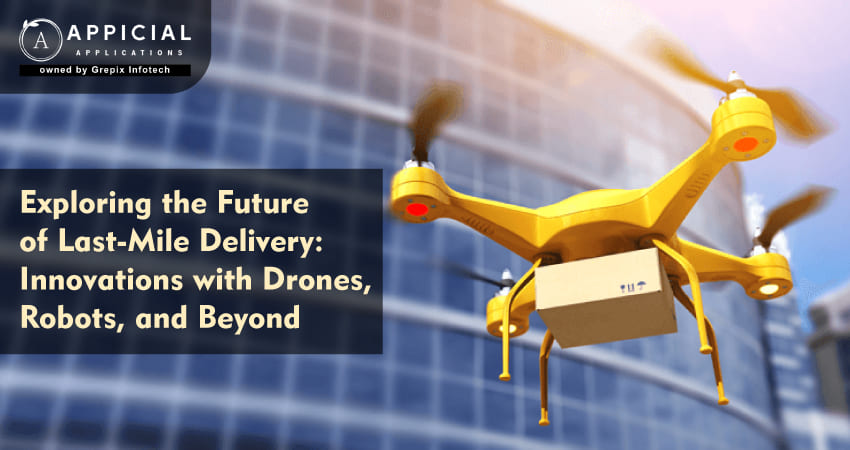
Exploring the Future of Last-Mile Delivery: Innovations with Drones, Robots, and Beyond
In an era where convenience and speed are paramount, the logistics industry is undergoing a profound transformation. The last mile of delivery—the final step in the journey of a package from a warehouse to a customer's doorstep—has always been a complex and costly challenge. With urban congestion, rising customer expectations, and increasing environmental concerns, traditional delivery methods are straining to keep up. Enter the age of innovation, where cutting-edge technologies like drones, robots, and autonomous vehicles promise to revolutionize last-mile delivery.
This blog delves into these groundbreaking advancements, exploring how they are set to reshape the future of delivery, making it faster, more efficient, and sustainable. Join us as we navigate through the skies with drones, traverse urban landscapes with delivery robots, and discover the hybrid solutions that combine the best of both worlds, heralding a new era of logistics and convenience.
The logistics industry is transforming with innovations in last-mile delivery, addressing challenges like urban congestion and high costs. Drones and ground robots offer speed, efficiency, and environmental benefits, while hybrid solutions combine their strengths. Autonomous vehicles, smart lockers, crowdsourced delivery, and AI further enhance delivery networks. Despite regulatory and technological hurdles, these advancements promise a faster, more efficient, and sustainable future for last-mile delivery. As these technologies evolve, they will redefine the logistics landscape, meeting the growing demands of modern consumers and creating a more efficient delivery ecosystem.
The Last-Mile Delivery Challenge
Before diving into the technological advancements, it’s essential to understand why last-mile delivery is such a critical challenge. This segment of the delivery process is fraught with inefficiencies due to several factors:
- Urban Congestion: Delivering packages in densely populated urban areas often leads to traffic congestion, which delays deliveries and increases costs.
- Customer Expectations: With the rise of e-commerce, customers now expect faster, often same-day, deliveries, adding pressure on logistics companies to expedite the last-mile delivery.
- High Costs: The final leg of delivery accounts for a substantial portion of the total shipping cost, driven by the need for more human resources, fuel, and vehicle maintenance.
- Environmental Concerns: The environmental impact of traditional delivery methods, primarily due to vehicle emissions, is a growing concern.
Also Read: Innovative Solutions from the Best Mobile App Development Company
Enter Drones: The Aerial Solution
Drones, or unmanned saverial vehicles (UAVs), have emerged as a promising solution to many of these challenges. These flying robots offer several advantages for last-mile delivery:
- Speed and Efficiency: Drones can bypass traffic and geographic obstacles, providing a direct and faster route to the delivery destination.
- Cost Reduction: By reducing the need for ground transportation, drones can significantly lower the costs associated with fuel, vehicle maintenance, and labor.
- Accessibility: Drones can reach remote or difficult-to-access areas, making deliveries possible in regions where traditional vehicles might struggle.
- Environmental Benefits: Electric drones produce zero emissions, contributing to a reduction in the carbon footprint of the delivery process.
Current Applications and Future Potential
Several companies are already experimenting with drone deliveries. Amazon’s Prime Air, Google’s Wing, and UPS’s Flight Forward are some of the pioneers in this space. These companies have conducted successful pilot programs, demonstrating the feasibility of drone deliveries for small packages.
In the future, we can expect drones to become more integrated into delivery networks. Advances in drone technology, such as longer battery life, improved navigation systems, and better payload capacities, will further enhance their practicality and efficiency. Moreover, regulatory frameworks are evolving to support the safe and widespread use of drones for commercial deliveries.
Ground Robots: The Rolling Revolution
While drones tackle the aerial aspect of last-mile delivery, ground-based delivery robots are making strides on the streets. These autonomous robots, often resembling small, wheeled containers, offer several benefits:
- Autonomy and Safety: Equipped with advanced sensors and AI, delivery robots can navigate sidewalks, avoid obstacles, and interact safely with pedestrians.
- Cost Efficiency: Like drones, robots reduce the dependency on human labor and fuel, driving down the operational costs of last-mile delivery.
- Operational Continuity: Ground robots can operate in various weather conditions and times of day, ensuring consistent delivery services.
Examples and Future Trends
Companies like Starship Technologies, Nuro, and Amazon Scout are at the forefront of ground robot deliveries. Starship’s robots, for example, have completed thousands of deliveries across different cities, showcasing their reliability and efficiency.
In the future, the integration of AI and machine learning will further enhance the capabilities of delivery robots. They will be able to learn from their environment, optimize routes in real-time, and provide even more reliable and efficient services. Additionally, the deployment of these robots in urban areas will become more commonplace, supported by advancements in smart city infrastructure.
Hybrid Solutions: Combining Drones and Robots
A hybrid approach, combining both drones and ground robots, is also gaining traction. This method leverages the strengths of both technologies to create a more efficient and flexible delivery system. For example, drones can handle the long-distance portion of the delivery, dropping packages at designated points where ground robots take over for the final leg to the customer’s doorstep.
This hybrid model not only optimizes the delivery process but also addresses some of the limitations of each technology. Drones can avoid urban congestion and cover larger distances quickly, while ground robots can navigate complex urban environments and deliver packages safely to the final destination.
Beyond Drones and Robots: Emerging Innovations
While drones and robots are the most talked-about innovations in last-mile delivery, several other technologies and approaches are also worth mentioning:
- Autonomous Vehicles: Self-driving delivery vans and trucks are being developed to automate larger portions of the delivery process. Companies like Tesla, Waymo, and Uber are making significant strides in this area.
- Smart Lockers: Secure, automated lockers placed in convenient locations allow customers to pick up their packages at their convenience. These lockers can be integrated with delivery drones and robots for a seamless delivery experience.
- Crowdsourced Delivery: Platforms like Uber Eats and Postmates leverage crowdsourcing to provide flexible and efficient last-mile delivery services. This model can be combined with autonomous technologies for even greater efficiency.
- AI and Big Data: Advanced analytics and AI can optimize delivery routes, predict customer demand, and improve the overall efficiency of last-mile delivery networks.
The Road Ahead: Challenges and Opportunities
The future of last-mile delivery is undoubtedly exciting, but it is not without its challenges. Regulatory hurdles, technological limitations, and societal acceptance are some of the key issues that need to be addressed. However, the potential benefits of these innovations far outweigh the challenges.
Regulatory Considerations
The deployment of drones and robots for last-mile delivery requires careful consideration of regulatory frameworks. Authorities need to ensure the safe integration of these technologies into existing infrastructure while addressing concerns related to privacy, security, and liability. Collaborative efforts between technology companies, regulators, and policymakers will be crucial in shaping a conducive environment for innovation.
Technological Advancements
Continuous advancements in AI, machine learning, and sensor technologies will be pivotal in overcoming the current limitations of drones and robots. Improved battery life, enhanced navigation systems, and better payload capacities are some of the areas where technological progress is needed.
Societal Acceptance
The acceptance and adoption of new delivery technologies by society will play a significant role in their success. Public perception, trust, and willingness to embrace these innovations are critical factors. Transparent communication, safety assurances, and demonstrated reliability will help build confidence in these new delivery methods.
Conclusion
The future of last-mile delivery is on the brink of a transformative shift. Innovations like drones, ground robots, and autonomous vehicles are poised to revolutionize the logistics industry, offering faster, more efficient, and environmentally friendly delivery solutions. As these technologies continue to evolve and mature, the last-mile delivery landscape will become more dynamic, adaptable, and capable of meeting the ever-increasing demands of modern consumers.
The journey towards this future will require collaboration, innovation, and a forward-thinking approach from all stakeholders involved. By embracing these advancements, we can create a more efficient and sustainable delivery ecosystem that benefits businesses, consumers, and the environment alike. The future of last-mile delivery is not just about reaching the destination; it’s about redefining the entire journey.
Launch your vision with our mobile app development company, where innovation meets excellence to create cutting-edge mobile solutions.







